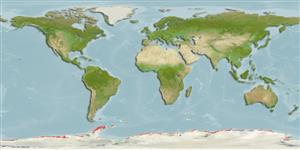>
Perciformes/Notothenioidei (Icefishes) >
Nototheniidae (Cod icefishes) > Nototheniinae
Etymology: Notothenia: Greek, 'notos', ou; νοτος, ου), from the south + Greek, 'e 'eutheneia',as or 'euthenia', as (ευθενεια, ας; ευθενια, ας), abundance (P. Romero, pers.comm. 01/16); neglecta: Named after Dr. Nybelin's feeling that this divergent form of coriiceps has been overlooked (Ref. 11892).
Environment: milieu / climate zone / profondeur / distribution range
Écologie
marin benthopélagique; profondeur 1 - 95 m (Ref. 11892), usually 1 - 90 m (Ref. 11892). Polar
Southern Ocean: coast of the Antarctic continent, Antarctic Peninsula, South Georgia, South Shetland, South Orkney Islands and Peter I Island.
Length at first maturity / Taille / Poids / Âge
Maturité: Lm 30.0 range ? - ? cm
Max length : 45.0 cm SL mâle / non sexé; (Ref. 11892)
Épines dorsales (Total) : 3 - 7; Rayons mous dorsaux (Total) : 37 - 40; Épines anales: 0; Rayons mous anaux: 27 - 32. Caudal fin subtruncate or slightly rounded, emarginate in young. Coloration more spectacular compared to other nototheniids. Juveniles with a black blotch on distal end of pectoral fin.
Body shape (shape guide): fusiform / normal.
Juveniles found in 1-10 m depth and possibly having a pelagic habit, adults in deeper water (Ref. 11892). Adults feed on crustaceans and fishes (Ref. 11892). Spawn once a year (Ref. 57661). Some information needs to be transferred from N. coriiceps to this species (RF).
Mature females may spawn for the first time from around 6-8 years of age (Ref. 71843).
Miller, R.G., 1993. A history and atlas of the fishes of the Antarctic Ocean. Foresta Institute, Nevada. 792 p. (Ref. 11892)
Statut dans la liste rouge de l'IUCN (Ref. 130435: Version 2025-1)
Menace pour l'homme
Harmless
Utilisations par l'homme
Pêcheries: pêcheries vivrières
Outils
Articles particuliers
Télécharger en XML
Sources Internet
Estimates based on models
Preferred temperature (Réf.
123201): -1.9 - -1.2, mean -1.7 °C (based on 342 cells).
Phylogenetic diversity index (Réf.
82804): PD
50 = 0.5312 [Uniqueness, from 0.5 = low to 2.0 = high].
Bayesian length-weight: a=0.00794 (0.00444 - 0.01422), b=3.24 (3.08 - 3.40), in cm total length, based on LWR estimates for this species & (Sub)family-body (Ref.
93245).
Niveau trophique (Réf.
69278): 3.3 ±0.2 se; based on diet studies.
Generation time: 12.1 ( na - na) years. Estimated as median ln(3)/K based on 2
growth studies.
Résilience (Réf.
120179): Faible, temps minimum de doublement de population : 4,5 à 14 années (tm=7-8; Fec > 10,000).
Fishing Vulnerability (Ref.
59153): Moderate vulnerability (42 of 100).
🛈
Nutrients (Ref.
124155): Calcium = 19.2 [10.9, 42.1] mg/100g; Iron = 0.329 [0.160, 0.631] mg/100g; Protein = 17.6 [15.1, 19.7] %; Omega3 = 0.297 [0.146, 0.594] g/100g; Selenium = 12.7 [5.5, 28.9] μg/100g; VitaminA = 18.9 [4.2, 87.4] μg/100g; Zinc = 0.545 [0.375, 0.800] mg/100g (wet weight); based on
nutrient studies.
